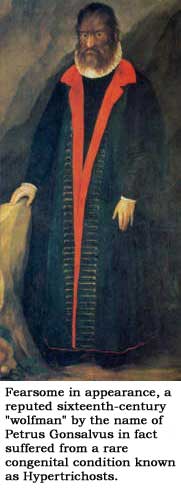|
|
|
|
|
Web Contents: Portrait of a Werewolf and the Transformation Process Werewolves' Cases From Medieval French Chronicles
Modern Werewolf Cases from Scientific View Point
|
Possible Explanations of Werewolf PhenomenonSo, what actually is werewolf or lycanthropy? Is it a fact based on concrete evidences? Is it a myth, fabrication of feeble minds? Is it an exaggeration of some other things? Well, all these questions have been puzzling mankind for last 5 centuries. Though many ingenious hypotheses have been suggested as possible explanations, definite conclusion can't be drawn. Some experts have tried to observe it as purely supernatural phenomena while others have relied on scientific observations. Contradictions and debates still persist and will continue till any single theory solves the jigsaw which seems unlikely considering complexity and diversity of the topic. Mythological Explanation of Werewolf Phenomenon Some people during middle ages believed that the werewolf was the projection of a demon, which made its victims appear as a wolf in his own eyes and to those around him. For others, the werewolf was a direct manifestation of the Devil. Early seventeenth century French author Henri Bouguet believed, as did a great many people of that day, that Satan would leave the lycanthrope asleep behind a bush, go forth as a wolf, and perform whatever evil might be in that person’s mind. According to Bouguet, the Devil could confuse the sleeper’s imagination to such an extent “that he believes he had really been a wolf and had run about and killed men and beasts.” Robert Burton, the clergyman and
scholar, considered lycanthrope to be a form of madness as mentioned in his book
Anatomy of Melancholy in 1621; he blamed every thing from sorcerers and witches
to poor diet, bad air, sleeplessness and even lack of exercise for this. Contrary to the popular explanations existed during middle ages, few doctors at that time asserted that it was caused by an excess of melancholy or an imbalance in humors, the liquid or fluid part of the body. Many doctors believed that such melancholy could lead to insanity and delusion. One physician recommended that the lycanthrope should be treated with baths, purging, bleeding, dietary measures and rubbing opium into the nostrils. Scientific Explanation of Werewolf Phenomenon: Food contamination The diet of medieval peasants may have been a source of werewolf delusions. Ergot infection on food grains like wheat and rye was common in Europe during the middle ages. This is actually a fungus which grows in place of grains in wet seasons after very cold winters. Alkaloids of this fungus are chemically related to LSD (LysergicAcid Diethylamide, a strong hallucinogenic psychoactive drug which produces dreamlike changes in mood and thought and alters the perception of time and space. It can create lack of self-control, extreme terror and blurring the feeling between the individual and the environment.) Similar to this modern drug, Ergot poisoning results in hallucinations, mass hysteria and paranoia. Continuous exposure to this contamination through bread or other food items could contribute to either an individual believing he is a werewolf or a whole town believing that they have seen a werewolf. A recorded Ergot poisoning case confirms this hypothesis. Nearly 135 people had to be hospitalized and 6 died poisoning in the French town of Pont St. Esprit in 1951. They ate bread made from Ergot infected rye. The victims had horrible visions of being attacked by tigers and snakes and of turning into beasts. However, Ergot contamination is not sufficient enough as a single cause to explain lycanthropy; werewolf appearance have been reported from other parts of the world where Ergot infection is rare. Substance Induced Hallucination Recorded werewolf cases and contemporary literatures mention rubbing magic ointment on the skin or inhaling vapor from magic potion by the alleged lycanthrope. The main ingredients of the ointment or potion were Belladonna or Nightshade that could produce hallucination and delusions of bodily metamorphose. This might explain how a wicked person make himself believe or act as a werewolf, but still the mystery of werewolf sighting remains ambiguous as it can’t induce same hallucination or delusions on surrounding people who has confirmed werewolf sightings. Physical or Mental Illness One branch of modern physicians refers lycanthropes as suffering from any of the five conditions; Rabies, Porphyria, Hypertrichosis, Body Image Distortion and psychological illness. A strain of virus carried by dogs, wolves and other animals including vampire bats causes Rabies. The virus strikes the central nervous system and produces uncontrollable excitement and painful contractions of the throat muscles’ intervention preventing the victim from drinking. Usually the patient dies within three or four days of first symptom. The second disease, Porphyria is a rare genetic disorder that results in a deficiency of heme, one of the pigments in the oxygen-carrying red blood cells. At the 1985 conference of the American Association for the Advancement of Science, biochemist David Dolphin suggested that the untreated symptoms of Porphyria match many of the traits associated with the classic lycanthrope. One of them is severe photosensitivity, which makes venturing out into daylight extremely painful and thus dooms the sufferer to a life of shadows and darkness. As the condition advances, the victim’s appearance grows increasingly morbid; discoloration of the skin and an unusual thick growth of facial or body hair occurs. There is a tendency for an abnormal change in skin and formation of sores. Eventually the disease attacks cartilage (the soft bone) and causes a progressive deterioration of the nose, ears, eyelids and fingers. The teeth, as well as the fingernails and the flesh beneath them might turn red or reddish brown because of deposition of Porphyrin, a component of Hemoglobin in the blood. Porphyria is often accompanied by mental disturbance, from mild hysteria to delirium and manic-depressive psychoses. The third disease Hypertrichosis
is also known as "Wolfitis", refers to a condition of excessive body hair
growth.
Defect in the part of the brain known to be involved in representing body shape causes body image distortion. A neuroimaging study of two people diagnosed with clinical lycanthropy showed that these areas display unusual activation, suggesting that when people report their bodies are changing shape, they may be genuinely perceiving those feelings. Body image distortions are not unknown in mental and neurological illness, so this may help explain at least part of the process. One further puzzle is why an affected person doesn't simply report that their body "feels like it is changing in odd ways", rather than presenting with a delusional belief that they are changing into a specific animal. There is much evidence that psychosis is more than just odd perceptual experiences so perhaps lycanthropy is the result of these unusual bodily experiences being understood by an already confused mind, perhaps filtered through the lens of cultural traditions and ideas. Psychologists have concluded that lycanthropes are actually patient of psychiatric syndrome that involves a delusional belief that the affected person is, or has, transformed into an animal. It has been linked with the altered states of mind that accompany psychosis (the reality-bending mental state that typically involves delusions and hallucinations) with the transformation only seeming to happen in the mind and behavior of the affected person. A study on lycanthropy from the McLean Hospital in New York reported on a series of cases and proposed some diagnostic criteria by which lycanthropy could be classified:
According to these criteria, either a delusional belief in current or past transformation, or behavior that suggests a person thinks of themselves as transformed, is considered evidence of clinical lycanthropy. The authors go on to note that although the condition seems to be an expression of psychosis there is no specific diagnosis of mental or neurological illness associated with its behavioral consequences. |
Advertisement Free Version of the Site is Available on the Following Location:
|


